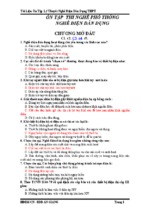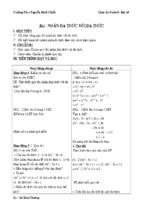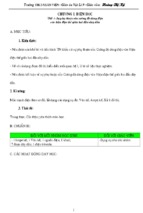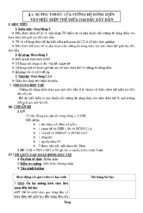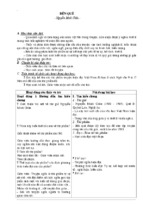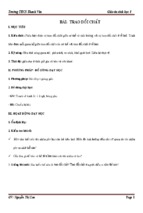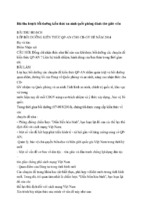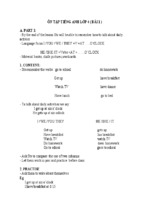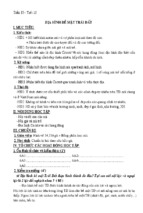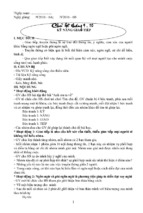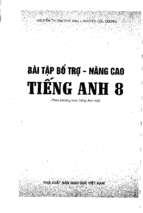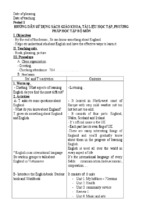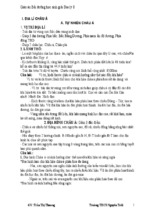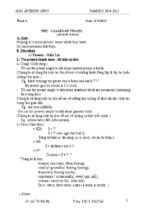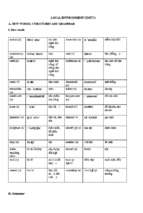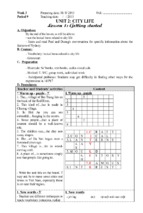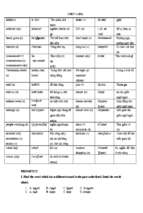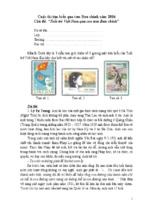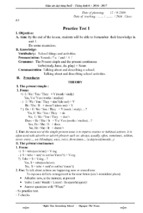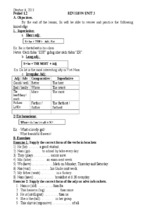TiÕt 01
Ngµy d¹y: 16/8/2010
revision
I. Aims
- To help students review some important grammatical structures which
they learned in English 8.
- To make students become more confident before they study English 9.
II. Objectives
Students review:
- The verb tenses: Simple present, simple past, simple future, present
continuous, present perfect tense.
- Indirect speech.
- The passive voice.
III. Materials
- Board, chalk,...
IV. Anticipated problems
Students may forget the spelling of ‘-ing’, ‘-er’ and ‘-ed’ forms.
V. Procedure
1. Warmer
- Greeting.
- Checking attendance.
- Asking for the teaching date.
2. Revision
Students review their old knowledge during the new lesson.
3. New lesson
Teacher’ s activities
Students’ activities
a. The verb tenses:
- Present simple:
- Work in groups of 4 each to
discuss the uses and the
forms.
- T listens and gives more information if - Each group has one students
necessary: S + Vs/es (Third person singular)
tell in front of the class.
S + V (Others left)
* The spelling of ‘-s/es’ forms.
- Present continuous:
- Work in groups of 4 each to
discuss the uses and the
forms.
- T listens and gives more information if - Each group has one students
necessary: S + is/am/are + Ving
tell in front of the class.
* The spelling of ‘-ing’ forms.
- Simple past:
- Work in groups of 4 each to
discuss the uses and the
forms.
- T listens and gives more information if - Each group has one students
necessary: S + Ved (Regular verbs)
tell in front of the class.
* The spelling of ‘-ed’ forms.
* Irregular verbs:
- Write some irregular verbs.
1
Buy - Bought
Make - Made
................
- Simple future:
- Work in groups of 4 each to
discuss the uses and the
forms.
- T listens and gives more information if - Each group has one students
necessary: S + will/shall + V(Infinitive)
tell in front of the class.
* We use shall for I and We.
Present perfect tense:
- Form?
- Use?
To talk about something which started in the
past and continues up to the present.
- We often use “For” and “Since” with the
present perfect tense.
+ For: A period of time.
+ Since: A point of time (starting point)
- yet, already, lately, recently, never, just,...
Exercise: Put the verbs in brackets into the
Simple present, present continuous, simple
past, simple future, present perfect tense and
then change them into the negatives and
interrogatives:
1. He (watch) TV.
2. She (do) her homework.
3. They (buy) a new car.
4. The children (sit) in the classroom.
5. The boys (play) football.
- S + have/has + PII
- S + have/has + not + PII
I haven’t seen him yet.
Have you seen him lately?
-Have/Has + S + PII
I have (I’ve) done my
homework.
- I’ve live here for 10 years.
- I’ve lived here since 1998.
- Individual work
Teacher elicits from students the formations - Ss do the exercises given by
teacher.
of the indirect speech and the passive form.
Exercises on Indirect speech:
Change the following sentences into indirect speech:
1. “I have something to show you,” I said to her.
2. “I’m going away tomorrow, mother,” he said.
3. “Does this train stop at York?” asked Bill.
4. “Is a return ticket cheaper than two singles?” said my aunt.
5. “Where is the ticket office?” asked Mrs. Jones.
6. He said, “What is happening?”
7. “When are you coming back?” I asked them.
8. “I’ll come with you as soon as I am ready,” she replied.
9. “Stand up, please!” he said.
10. “You should study harder.” the teacher advised Nam.
11. Peter said to Paul, “Are you working as well as studying?”
12. “Can you get coffee on the train?” said my aunt.
Exercises on the passive voice:
Change the following sentences into the passive voice:
1. They make shoes in that factory.
2. They built that skyscraper in 1934.
2
3. You must wash your hands before meals.
4. Peter writes a letter.
5. Somebody built the house last year.
6. They speak English in the shop.
7. She can sew three shirts a day.
8. She gave me the box.
9. The students handed in the reports.
10.Steven forgot the book.
4. Consolidation
Teacher retells and emphasizes the structures students have reviewed.
5. Homework
Put the verbs into the correct tense (Simple Past or Past Progressive).
1. While Tom (read) , Amely (watch) a documentary on TV.
2. Marvin (come) home, (switch) on the computer and (check) his emails.
3. The thief (sneak) into the house, (steal) the jewels and (leave) without a
trace.
4. Nobody (listen) while the teacher (explain) the tenses.
5. While we (do) a sight-seeing tour, our friends (lie) on the beach.
6. He (wake) up and (look) at his watch.
7. I (jog) in the park, when two squirrels (cross) my way.
8. Robert (fall) off the ladder when he (pick) cherries.
9. Archimedes (discover) the theory of buoyancy while he (take) a bath.
10.When we (travel) around Ireland, we (meet) some very nice people.
Unit 1
TiÕt 02
A visit from a pen pal
Ngµy d¹y: 18/8/2010
Getting started & listen and read
I. Aims
- Reading the text to understand the details.
- Presentation and practice in “wish” to talk about unreal present desires.
II. Objectives
By the end of the lesson, students will be able to:
- Understand the details of the text about Lan and her Malaysian pen pal.
- Understand and use “Wish” to talk about unreal present desires.
III. Materials
- Text book
- Board, chalk,...
- A cassette and an audio compact disk.
IV. Anticipated problems
Students may get confused when using “wish” to express their unreal
wishes.
V. Procedure
1. Warmer
3
- Greeting.
- Checking attendance.
- Asking for the teaching date.
2. Revision
Teacher gets some students to stand in front of the class and tell some
important grammatical problems they learned in English 8.
3. New lesson
Teacher’ s activities
Students’ activities
a. Getting started:
- What activities would you do if a foreign pen - Guess the activities from
pal is coming to stay with you for a week?
picture a) – f) P.6 (Students
can express their own ideas.
a. Going to Hung’s Temple.
- Work in pairs and compare
b. Visiting the Literature Temple in Hanoi. in groups of 4.
c. Going to Dong Xuan Market or Going
shopping.
d. Visiting the museum.
e. Eating out.
f. Going to the theater.
b. Presentation:
Pre teach:
- Tell the meaning of the new
I. New words:
+ To correspond [,kɔris'pɔnd] = to write to words in Vietnamese.
- Repeat in chorus.
another.
- Read in individuals.
+ To be impressed (by): BÞ g©y Ên tîng (bëi)
+ To pray: (Mime)
+ To depend [di'pend] on: Phô thuéc vµo.
- Check the spelling and
+ To keep in touch: Gi÷ mèi liªn l¹c.
pronunciation.
+ A mosque [mɔsk]: Nhµ thê Håi Gi¸o.
- Copy down on the notebooks
- Teacher reads once again
Pre questions:
Set the scene: Razali Maryam is Lan’s pen pal.
She came to stay with Lan last week. You are
going to read a text about Maryam and her
visit to Vietnam:
1. Where did Lan take Maryam to?
2. Did Maryam invite Lan to visit her country?
II. Listen and read
Presentation text: Listen and Read P.6,7
- Plays the disk.
1. Check the prediction
- Answer key:
1. - Hoan Kiem Lake.
- Ho Chi Minh’s Mausoleum/ the History
Museum and Van Mieu.
- Many beautiful lakes and parks in Hanoi,
the mosque on Hang Luoc Street.
2. Yes, she did.
2. Multiple choice: 1-5 p.7,8
3. Grammar note:
Model sentence:
4
- Work in groups of 4 to
predict the answers to the
questions.
- Listen following the text.
- Read in individuals to find
the correct answers to the
questions.
- Read the text again then
choose the correct option to
complete the sentences.
- “I wish you had a longer
vacation.”
- Teacher elicits the model sentence from
students: What did Lan say to Maryam?
I wish you had a longer vacation
*Concept check:
- Does Lan want Maryam to have a longer
vacation?
- Can Maryam stay longer?
- Can her wish come true now?
- Does the sentence express unreal present or
past desire?
- What tense is used for the verb in the
subordinate clause?
Notes: “Wish” in the sentence above is used
to express unreal present desire. The simple
past tense is used in the subordinate clause.
For the verb ‘to be’, “Were” is more often
used than “Was”.
S 1+ (WISH) + S2 + V(Simple past tense)
III. Practice
c. Practice:
Repetition drill:
1. Can’t visit Malaysia
2. Can’t see that film
3. don’t have a trip abroad.
d. Futher practice:
Teacher gives unreal situations:
- Yes.
- No.
- No.
- No
- Unreal present desire.
- The simple past tense.
- T: can’t visit Malaysia.
- Ss: I wish I could visit
Malaysia.
- Students use ‘Wish’ to finish
the second sentence (orally):
1. I wish I knew her address.
2. We wish we had a map.
1. I want to phone her but I don’t know her
3. We wish she were here now
address.
2. We’ve lost the way because we don’t have a
4. We wish they would come
map.
with us.
3. Marie isn’t here now.
5. We wish today were a
holiday.
4. They won’t come with us.
5. Today is not a holiday.
4. Consolidation
Teacher retells and emphasises the structures using ‘Wish’ students have
studied.
5. Homework
- Prepare for the next lesson: Unit 1: Speak + Language focus 1.
- Do exercise 7 page 10 (workbook).
- Do exercise IX page 9,10 (Bµi tËp bæ trî-n©ng cao TiÕng Anh 9).
5
Unit 1
A visit from a pen pal
TiÕt 03
Ngµy d¹y: 23/8/2010
Speak + language focus 1
I. Aims
In order to help students practise speaking.
II. Objectives
By the end of the lesson, students will be able to improve the dialogue
based on the provise phrases (P.18)
III. Materials
- Text book
- Board, chalk,...
- Word cards.
IV. Anticipated problems
Students may get difficulties in finding words and phrases to express their
ideas.
V. Procedure
1. Warmer
- Greeting.
- Checking attendance.
- Asking for the teaching date.
2. Revision
Jumbled words:
Troicendu = introduce
Derscopron = correspond
Mispres = impress
Daroba = abroad
Answer the questions:
1. Where does Lan’s pen pal come from?
2. How long have they been pen pals?
3. How often do they correspond to each
other?
4. When did Maryam come to stay with Lan?
5. Where did Lan take Maryam to?
3. New lesson
Teacher’ s activities
a. Pre speaking:
I. Speaking:
1. Speak a P.8
Ordering:
6
- Team work.
- Students write their answer on
the notebooks. (Individually)
- Teacher collects some
notebooks and give feedback.
- Teacher gives correct
answers.
Students’ activities
- Students read the dialogue
silently and put the dialogue
* Set the scene: “Nga is talking to Maryam.
They are waiting for Lan outside her school.”
- What activities would you do if a foreign pen
pal is coming to stay with you for a week?
- Teacher has students give their answer.
- Teacher elicits the correction from students.
Answer key:
1c – 5b – 4d – 2e – 3a – 6.
b. While speaking:
2. Speak b P.8
Example:
a. Yoko from Tokyo, Japan:
in the correct order.
- Compare their work in pairs.
- Copy down.
- Students practise
dialogue in pairs.
the
- Students take turns to be one
of Maryam’s friends to make
similar dialogues.
Lan: You must be Yoko – Maryam’s friend.
Yoko: Yes. That’s right. I am.
Lan: Pleased to meet you, Yoko. Let me introduce
myself. I’m Lan’s classmate.
Yoko: Pleased to meet you.
Lan: Are you enjoying your stay in Vietnam?
Yoko: Yes, very much. I’d like Vietnamese people
because they are very friendly. I love old cities in
Vietnam like Hue and Hanoi.
Lan: Is Hanoi different from Tokyo?
Yoko: Yes. The two cities are the same in some ways.
They are both big and busy capital cities.
- Teacher monitors and gives help.
- Teacher has some pairs practise their
dialogue before the class.
II. Language focus 1 P.11
Example exchange:
S1: What did Nga do on the weekend?
S2: She went to the concert – Hanoi singers.
S1: When did she see it?
S2: She saw it on Saturday morning at 8
o’clock.
c. Post Speaking:
III. Practice:
Write it up:
Example:
- Practise in pairs.
- Read the information given
in the box, work in pairs to
make similar dialogues.
- Write. Change the dialogue
into narratives. (Individual
work)
a. Yoko is one of Maryam’s friends. She comes
from Tokyo, Japan. Tokyo is the same as
Hanoi capital. It is a big and busy city. Last
week Yoko came to stay with us. We took her
to some tourist attractions like Van Mieu, Ho
Chi Minh’s Mausolem, the History Museum...
She likes.....She loves.....
b. ...
4. Consolidation
Teacher retells and emphasises the aims.
5. Homework
- Prepare for the next lesson: Unit 1: Listen+ Language focus 2, 3.
- Do exercise 1, 2, 3 page 5-7 (workbook).
7
Unit 1
TiÕt 04
A visit from a pen pal
Ngµy d¹y:..... /8/2010
Listen + language focus 2, 3
I. Aims
Practice in listening skill. Listen and choose the picture and practice the
past simple tense with “wish”.
II. Objectives
By the end of the lesson, students will be able to get the information from
the text.
III. Materials
- Text book, a cassette
- Board, chalk, audio disk...
- Pictures.
IV. Anticipated problems
Students may meet with difficulties in listening to the disk voice.
V. Procedure
1. Warmer
- Greeting.
- Checking attendance.
- Asking for the teaching date.
2. Revision
- Work in groups of 4 each to
Simple past:
- T listens and gives more information if necessary: S discuss the uses and the
+ Ved (Regular verbs)
forms.
* The spelling of ‘-ed’ forms.
- Each group has one students
* Irregular verbs:
tell in front of the class.
Buy - Bought…
Make - Made
- How to make “Wh” questions in the simple past?
- Write some irregular verbs.
3. New lesson
Teacher’ s activities
Students’ activities
I. Language focus:
S 1+ (WISH) + S2 + V(Simple past tense)
Language focus 3 P.12
T: How can we use “wish” to express the - Individual work then
unreal present desire?
compare in pairs.
- Teacher check with the whole class.
- Look at the pictures, read the
Language focus 2 P.12
- Gets students to write about Lan and her words given in the box and
match the verbs with the
friends preparing for a farewell party.
nouns to understand what Lan
1. Lan made a cake.
2. Ba hung colourful lamps on the walls of Lan’s and her friends did to prepare
for the party.
room to make it brighter.
8
3. Nga went to the market to buy a bunch of - Individual work then pairs
flowers.
compare.
4. Nam painted a picture of Hanoi to present
Maryam.
Tam and Huong went to the market to buy some
fruit.
II. Listening
a. Pre listening:
* Set the scene: “Carol is Tim’s pen pal. She is
from Mexico. She is visiting the USA. Tim
suggests doing something.”
Guessing:
a. Keep off the grass / Don’t walk on the
grass.
b. Go by bus / Which bus to take: the 103
bus ur the bus number 130?
c. Eat in a Mexican restaurant or eat
Hamburgers?
Pre question:
1. Where does Tom suggest doing?
2. How are they going?
- Look at the pictures on page
9 and tell what each picture
means.
- Predict the answers to the
questions.
- Listen to the disk then find
the answers to the pre
questions.
3. Does Carol like walking in the park?
b. While listening:
Checking prediction:
1. going to a restaurant down town.
2. going by bus
3. Yes, she does.
Multiple choice:
a. Keep off the grass.
b. Take the bus number 130.
c. Eat hamburgers.
Comprehension questions:
- Teacher has students read the questions then
plays the disk again.
1. Where does Tim suggest going?
2. How are they going?
3. What’s the park like?
4. What does Tim remind Carol to do while
they are walking in the park?
5. Which bus are they going to take?
6. What are they going to eat?
- Teacher has students give their answers and
elicits the correction from students if necessary.
III. Practice:
c. Post listening:
Writing:
Tim suggests going to a restaurant
downtown. They are going by bus. It’s so
beautiful with trees, flowers and a pond in the
middle. He reminds her to keep off the grass.
They are going to take the bus number 130.
They are going to eat hamburgers.
4. Consolidation
- Listen and write the answer
to the questions (Short
answers)
- Listen to the disk again and
check the correct pictures.
- To a restaurant down town.
- By bus.
- beautiful.
- To keep off the grass.
- number 130.
- hamburgers.
- Write full answers to 6
questions in “While listening”
to make a passage about Tim
and Carol’s visit to the down
town.
9
Teacher retells and emphasises the aims.
5. Homework
- Prepare for the next lesson: Unit 1: Read.
- Do exercise 5, 6 (workbook), look for information about Malaysia.
- Do exercise II, VII, VIII P.6, 8-9 (Bµi tËp bæ trî-N©ng cao tiÕng Anh 9)
Unit 1
TiÕt 05
A visit from a pen pal
Ngµy d¹y....../8/2010
read
I. Aims
Reading for details about Malaysia, a member of ASEAN.
II. Objectives
By the end of the lesson, students will be able to understand and retell the
text.
III. Materials
- Text book
- Board, chalk, map...
- Wordcards.
IV. Anticipated problems
Students might know little about Malaysia.
V. Procedure
1. Warmer
- Greeting.
- Checking attendance.
- Asking for the teaching date.
2. Revision
Chatting:
- Do you remember Maryam?
- Who is she?
- Where is she from?
- Where is Kuala Lumpur?
3. New lesson
Teacher’ s activities
a. Pre reading:
Pre teach:
- to divide [di'vaid]...into: Chia ra
- to separate ['seprət] from: T¸ch ra tõ...
- be separated by
- to comprise [kəm'praiz]: Bao gåm (to consist of)
- compulsory [kəm'pʌlsəri]: b¾t buéc
- a federation [,fedə'rei∫n]: liªn ®oµn
- territory ['terətri] : Vïng l·nh thæ.
10
- Group work.
- Teacher – Whole class
Students’ activities
- Tell the meaning of the new
words in Vietnamese.
- Repeat in chorus.
- Read in individuals.
- Check the spelling and
pronunciation.
- Copy down on the notebooks
Checking vocabulary: R0R.
T/F statements prediction:
- Predict the answers to the
1. Malaysia is a country of ASEAN.
questions.
2. There are two religions in Malaysia.
3. People speak only Malay in Malaysia.
4. Primary school children learn three language at
school.
5. All secondary school children learn in English.
b. While reading:
T/F statements:
- Read the text about Malaysia
Answer keys:
then check and correct the
false statements.
1. T
4. T
2. F. There are three religions in Malaysia.
3. F. People speak only Malay in Malaysia.
5. F. All secondary school children learn in
Malay.
Grid:
- Read the text in silence then
5. Capital city: Kuala
1. Area: 329,758 km2
complete the table. (Read a
Lumpur
P.10)
2. Population: over
22.000.000
3. Climate: tropical
4. Unit of currency:
Malaysia ringgit
6. Official religion:
Islam
7. National language:
Bahasa Malaysia
8. Compulsory second
language: English
c. Post reading:
Discussion:
- What do you know about Malaysia?
Write it up
- Read the information they have
found in read a) again then work in
groups of four to talk about Malaysia.
- Write what they know about
Malaysia. (Individual work)
4. Consolidation
Teacher retells and emphasises the structures using ‘Wish’ students have
studied.
5. Homework
- Prepare for the next lesson: Unit 1: Write.
- Do exercise 4 page 7,8 (workbook).
- Exercise I, III, IV, V, VI P.5-8 (Bµi tËp bæ trî-N©ng cao tiÕng Anh 9)
Unit 1
TiÕt 06
A visit from a pen pal
Ngµy d¹y 01/9/2010
Write
I. Aims
Giving students practice in writing a letter to their parents or friends about
their visit to another part of the country or a different country.
II. Objectives
11
By the end of the lesson, students will be able to write a letter telling about
their trip to their friends or relatives in Viet Nam or in different countries.
III. Materials
- Text book
- Board, chalk,...
- Poster.
IV. Anticipated problems
Students may get difficulties in finding words and phrases to express their
ideas.
V. Procedure
1. Warmer
- Greeting.
- Checking attendance.
- Asking for the teaching date.
2. Revision
Chatting:
- Teacher – Students
- Have you ever been to another part of our
country?
- Group work
- When did you go?
- Opening: Dear...,
- Who did you go with?
- Body of the letter
- How did you go?
+ First paragraph
+ Second paragraph
Form of a personal letter?
+ Third paragraph
- Closing: Yours...
3. New lesson
Teacher’ s activities
I. Pre writing:
* Set the scene: “Imagine you are visiting
another part of Vietnam. Write a letter to your
friend or parents.”
Making outline:
First paragraph:
- Where / you now?
- Have a good or terrible journey?
- Travel by...? / How long...?
- When / arrive?
- Who / met / at...?
Second paragraph:
- What / do / the day / arrive?
- On the following days?
- (Visit/take photos/eat/buy souvenirs)
- Meet your friend?
Third paragraph:
- Have a good time?
12
Students’ activities
- Students work in pairs, ask
and answer questions using
the information given above to
tell each other about their
visit.
* Example:
S1: Where are you now?
S2: I’m on holiday in Ho Chi
Minh City.
S1: Did you have a good
journey?
S2: No. The weather was
awfully bad on the day I went.
......
- How / feel / like / stay?
- (The sights / food / people)
- When / come back?
II. Writing:
- Teacher monitors, takes notes of typical - Write their letter (Individual
work)
mistakes and helps if necessary.
Suggested letter:
Dear Mom and Dad,
I’m now on holiday in HCM City. We had a terrible
journey. We went by train. The weather was awful. It
rained all the time. And the train was delayed for
three hours.
So it took 50 hours to travel from HN to HCM City. I
think I will never travel by train again. I was so late
that nobody met me at Saigon Station. I took a taxi to
our uncle’s house. They were so glad to see me.
I was rather tried on the day I arrived. I didn’t do
much for the first two days. On the following days, we
spent most of the time visiting Dam Sen Park...
I’m having a good time in HCM City now. I enjoy the
foods because they are delicious. I like the sights
because they are beautiful. I love the people, too.
They are helpful and friendly. However, I miss you
both and I wish you were here now. If you were here
we would have more fun. I’ll come back on 25 th
September and please pick me up at the Noi Bai
Airport at...
Love
III. Post writing:
- Writes typical mistakes on the board and
- Swap their writing and
elicits the correction from students.
- Gets some students to read their letters correct any mistakes if
necessary.
before the class.
4. Consolidation
Teacher retells and emphasises the way to write a personal letter.
5. Homework
- Prepare for the next lesson: Unit 2: Getting started + Listen and read.
- Do exercise 8 P.11 WB.
- Exercise X Page 10-11 (Bµi tËp bæ trî-N©ng cao tiÕng Anh 9)
- Complete this letter:
Dear Lan,
1. very happy / get / your mail.
2. I / back / from / holiday / countryside.
3. It / one / most / interesting trip / have.
4. I / play / lots / traditional games / eat / fresh / fruits.
5. What / about / you? Nice weekend?
6. Please write / back / me / soon / as / possible.
Love.
Answer key:
Dear Lan,
1. I am very happy to get your mail.
13
2.
3.
4.
5.
6.
14
I have come back from my holiday in the countryside.
It was one of the most interesting trip I had.
I played lots of traditional games and ate fresh fruits.
What about you? Did you have a nice weekend?
Please write back to me as soon as possible.
Love.
Unit 2
clothing
TiÕt 07
Ngµy d¹y......./9/2010
Getting started & listen and read
I. Aims
- Presenting vocabulary to talk about the development of the “ao dai”
II. Objectives
By the end of the lesson, students will be able to know about the
traditional clothes of some nations and Ao Dai in Vietnam.
III. Materials
- Text book
- Board, chalk,...
- A cassette and an audio compact disk.
IV. Anticipated problems
Students may not know about the traditional clothes of some nations in
“Getting started”.
V. Procedure
1. Warmer
- Greeting.
- Checking attendance.
- Asking for the teaching date.
2. Revision
In the new lesson.
3. New lesson
Teacher’ s activities
Students’ activities
I. Getting started:
- Elicits the answers from students.
- Look at the pictures of
people wearing the national
a. She comes from Japan.
b. She comes from Vietnam.
dresses of their country
(Pictures a-f) on page 12 and
c. He comes from Scotland.
d. She comes from India.
describe where each person
comes from.
e. He comes from the USA.
f. She comes from Arabia (Saudi).
II. Presentation:
1. New words:
Forming the words (revision):
To design
To wear
To symbolize
Tradition
Frequently
Poem
Modern
(N)Designer / design
Simple past/PII: wore/worn
Noun: Symbol
Adj / Adv: Traditional(ly)
Adj: Frequent
Noun: Poet / Poettry
Verb: Modernize
- Forming the words.
- individual work then discuss
in groups of 4 each.
- Tells students any words that they can’t
change the form.
15
New words:
- To take inspiration [,inspə'rei∫n] from: LÊy c¶m
høng tõ...
- Loose > < tight
- Minority [mai'nɔriti]: ThiÓu sè > < Majority
[mə'dʒɔriti]
- Velvet ['velvit]:
Nhung
- Stripes: V¹ch kÎ
- a long silk tunic ['tju:nik]: ¸o lôa dµi.
Checking Vocabulary: R0R
- Set the scene: You are going to read the text
about the traditional dress of Vietnam – The
ao dai.
2. Pre questions:
1. What’s our national dress?
2. What’s it made from? – Silk or velvet or
both?
3. Who often wears it?
4. When do they often wear it?
3. Listen and Read P.13
- Plays the disk.
- Answer key:
1. The ao dai is.
2. It’s either made from silk or velvet.
3. Women often wear it.
4. They often wear it on special occasions.
III. Practice:
1. Complete the sentences:
- Listen&Read a P.14
- Checks the answers.
1. poems, songs and novels.
2. traditional dress of Vietnamese women.
3. to wear modern clothing at work.
4. lines of poetry on it.
5. traditional designs and symbols like suns,
stars, crosses and stripes to velvet.
2. Comprehension questions:
- Listen&Read b P.14
- Tell the meaning of the new
words in Vietnamese.
- Repeat in chorus.
- Read in individuals.
- Check the spelling and
pronunciation.
- Copy down on the notebooks
- Work in groups of 4 to
predict the answers to the
questions.
- Listen following the text.
- Read in individuals to find
the correct answers to the
questions.
- Individual work.
- Share answers with their
partners.
- Pair work.
1. By traditional, men and women used to wear the ao
dai.
2. The majority of Vietnamese women prefer to wear
the ao dai at work because it’s more convenient.
3. To modernize the ao dai, fashion designers have
printed lines of poetry on it. And they have added
traditional designs and symbols like suns, stars,
cresses and stripes to velvet.
- Work in groups of four each
IV. Futher practice:
to talk about the ao dai.
Discussion:
1. When / where / why women in Vietnam like
wearing the ao dai?
2. The changes to the traditional ao dai.
4. Consolidation
Teacher retells and emphasises the structures using ‘Wish’ students have
studied.
16
5. Homework
- Prepare for the next lesson: Unit 2 : Speak.
- Write some sentences about the Ao dai.
- Write up what they discussed and talked about in the “Discussion”.
- Do exercise II, IV, VIII P. 13-15, 17 (Bµi tËp BTNC tiÕng Anh 9)
TiÕt 08
Unit 2
clothing
Ngµy d¹y......./9/2010
Speak
I. Aims
Giving students more practice in talking about the clothes they like to
wear on different occasions.
II. Objectives
By the end of the lesson, students will be able to talk about their habits or
interests in different types of clothes.
III. Materials
- Text book
- Board, chalk,...
- Word cards.
IV. Anticipated problems
Students may get difficulties in finding words and phrases to express their
ideas.
V. Procedure
1. Warmer
- Greeting.
- Checking attendance.
- Asking for the teaching date.
2. Revision
Noughts and crosses: Talking about the ao
dai.
1. What is our traditional dress?
2. What is it made of?
3. What is the ao dai described as?
4. Who used to wear the ao dai by traditional?
5. Why do the majority of Vietnamese women prefer
to wear modern clothing at work?
6. What have fashion designers done to modernize
the ao dai?
7. On what day do you have to wear school uniform?
8. What do your teachers often wear on Teachers’
Day?
9. What colour is your school uniform?
3. New lesson
Teacher’ s activities
- Team work.
1
2
3
4
5
6
7
8
9
Students’ activities
17
a. Pre speaking:
I. New words:
Pre teach:
- Teacher uses the words of different clothes
on page 17 (or other clothes Ss are wearing)
to teach these words:
- Plaid [plæd]: KÎ ca r«
- Sleeve [sli:v]: Tay ¸o - Sleeveless: Céc tay
- Fade ['feid]: B¹c mµu
- Plain [plein]: tr¬n (Kh«ng cã hoa)
- Casual ['kæʒjuəl]: B×nh thêng, kh«ng trÞnh träng.
Checking: What and where.
II. Speaking:
1. Matching:
- Speak a) P.15
a. a colourful Tshirt
b. a sleeved
sweeter
d. a plain suit
e. faded jeans
g. baggy pants
h. a plaid skirt
b. While speaking:
2. Questions:
- Tell the meaning of the new
words in Vietnamese.
- Repeat in chorus.
- Read in individuals.
- Check the spelling and
pronunciation.
- Copy down on the notebooks
- Read the phrases and try to
f. a shotr-sleeved guess the meaning of each
blouse
phrase.
i. blue shorts - Do the matching.
- Repeat the phrases in chorus.
c. a striped shirt
1. What do you usually wear on the weekend?
- Read the questions on page 14,
Why do you usually wear these clothes?
then work in pairs to add three
2. What is your favorite type of clothing? more questions.
Why?
3. On what day do you wear school uniform?
What colour is it?
4. What type of clothing do you wear on Tet /
your birthday? What would you wear to a
party?
3. Survey:
- Speak b P.15
Name
Hoa
Casual
clothes
Favorite
clothes
School
uniform
A short
sleeved
blouse/
baggy pants
cool,
comfortable
Short
baggy
pants and
short
sleeved
blouse
Wear it
every day
except for
Sunday.
Comfortab
le, dark
blue and
white
c. Post Speaking:
Feedback:
Clothes for
special
occasions
Jeans and a
long
sleeved
blouse.
Look
stronger in
these
clothes
- Use the given questions to
make a survey.
- Ask 1 or 2 of their classmates
to get information to complete
the table.
Lan: Hoa said she often wore a short-sleeved
blouse and baggy pants. She said she like them
because they were cool and comfortable. She said - Students tell their class what
her favorite clothes were short baggy pants and
short sleeved blouse. She said she wore school they have interviewed.
uniform every day except for Sunday. She said it
was comfortable and it had dark blue and white...
4. Consolidation
Teacher retells and emphasises the aims.
5. Homework
18
- Prepare for the next lesson: Unit 2: Listen.
- Do exercise 1,2 page 12-14 (workbook).
- Do exercise III P.15 (Bµi tËp BTNC tiÕng Anh 9).
19
TiÕt 09
Unit 2
clothing
Ngµy d¹y......../9/2010
listen
I. Aims
Giving students practice in listening for details and describing people.
II. Objectives
By the end of the lesson, students will be able to describe others. (clothes,
age, hair)
III. Materials
- Text book
- Board, chalk,...
- Pictures.
IV. Anticipated problems
Students may meet with difficulties in listening to the disk voice and
maynot call out the names of clothes in the pictures.
V. Procedure
1. Warmer
- Greeting.
- Checking attendance.
- Asking for the teaching date.
2. Revision
Net work:
- Group work of four.
- Discuss and write the names
of clothes.
- Some students take turns to
read aloud the word they
have, others listen and add the
words they don’t have to their
list.
3. New lesson
Teacher’ s activities
a. Pre listening:
Question and answer:
* Suggested questions:
1. What do you call these clothes in English?
2. What kind of blouse is it?
3. Are these shoes or sandals?
a. A. pants B. blue shorts
C. a skirt
20
Students’ activities
- Look at the pictures (Listen
a-c P.16), ask and answer
questions about the clothes or
shoes...
- Repeat the phrases in chorus.
- Xem thêm -

